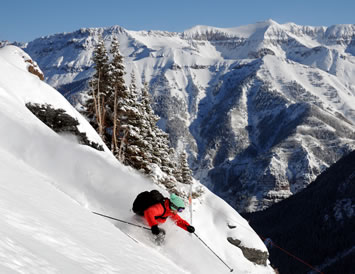Quite often, we have guests experiencing the unfortunate, and unwanted signs of altitude sickness. Some of our guests are surprised that they are experiencing altitude sickness because they consider themselves to be fit. Some guests don’t even realize that their sickness is altitude related. The town of Telluride is situated at 8750 feet. Mountain Village is even higher with accommodations between 9400-10000 feet. To break it down in most simple terms, there is almost 30% less oxygen in the air in Telluride than at sea level. That means your body has to work harder to get the oxygen it needs. Add to this, most people come to Telluride to ski, hike and bike which means that your body experiences quite a shock with the shift in altitude. The aim of this blog is to help you prevent, identify and manage signs of altitude sickness. This information comes from the Institute for Altitude Medicine, based right here in beautiful Telluride, Colorado.
What are the symptoms of altitude sickness?
To meet the definition of AMS, other symptoms need to dev elop, such as loss of appetite, sometimes vomiting, weakness, dizziness, fatigue, and difficulty sleeping.AMS feels exactly like a bad hangover.Symptoms can occur as early as 2 hours after arrival to altitude, or be delayed for 24 hours or so. –Institute for Altitude Medicine website.
How can I prevent and manage the symptoms of altitude sickness?
The IAMT has the following tips:
- Slow ascent to altitude is the key to acclimatizing well. An overnight stay at an intermediate altitude such as Denver (5280 ft) or preferably a bit higher prior to further ascent into the mountains is very helpful. If traveling to Telluride, overnighting in Ridgway, Ouray, Placerville or Durango would be helpful, especially if the destination is Mountain Village.
- Staying hydrated is important as it aids your body in acclimatizing.
- Avoid use of alcohol or sleeping agents of the benzodiazepine family, since they both suppress breathing and result in lower blood oxygen. Other sleeping pills like Ambien or Lunesta do not affect breathing at high altitude and are safe. Avoid over-exertion for 1-2 days after arrival to altitude.
- Acetazolamide (Diamox®) taken 24 hours prior to arrival to altitude and the first 2 days at altitude is 75% effective in preventing AMS. It speeds up the acclimatization process in the body, stimulates breathing, raises blood oxygen and increases urination.
- Gingko biloba, according to some studies was effective in preventing AMS when started 5 days prior to ascending to altitude, at a dose of 100 mg twice a day.
- Avoiding exposure to viral illness such as coughs and colds will improve your chances of staying healthy. When traveling consider wearing a mask if exposed to someone with a severe cough. Use proper hand washing and good hygiene to avoid transferring germs.
The IAMT also dispels some myths about altitude sickness. More information on these points can be found at http://www.altitudemedicine.org/:
Myth #1– Don’t drink caffeine at altitude.
Myth #2 – Diamox masks symptoms of altitude sickness.
Myth #3 – Physical fitness protects against altitude sickness.
Myth #4 – Drinking extra water will protect you from altitude illness.
Myth #5 – Children are more susceptible to altitude illness.
Of course, if you are unsure of your symptoms, you should visit the Telluride Medical Center for a full medical evaluation.

